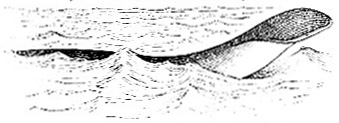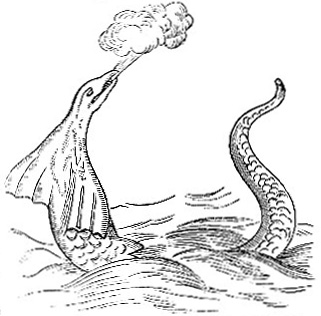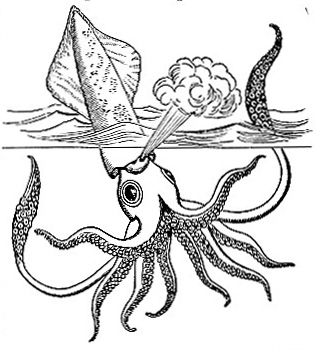1902 Encyclopedia > Sea Serpent
SEA-SERPENT. The belief in enormous serpents, both terrestrial and marine, dates from very early times. Pliny (H. N., viii. 14), following Livy (Epit., xviii.) tells us of a land-serpent 120 feet long , which Regulus and his army besieged with ballistae, as though it had been a city, and this story is repeated by several other writers (Florus, ii, 2; Val. Max., i. 8 ; Gellius, vi. 3).
The most prolific in accounts of the sea-serpent, however, are the early Norse writers, to whom the "Sö-Orm" was a subject both for prose and verse. Olaus Magnus (Hist. Gent. Sept., xxi. 24) describes it as 200 feet long and 20 feet round, and states that it not only ate calves, sheep, and swine, but also "disturbs ships up like a mast, and sometimes snaps some to the men from the deck" illustrating his account with a vivid representation of the animal in the very act. Pontoppidan, in his Natural History (Eng. tr., 1755, p. 195 sq.), says that its existence was generally believed in by the sailors and fishermen of his time, and recounts the means they adopted to escape it, ads well as many details regarding the habits of the creature.
The more circumstantial records of comparatively modern times may be most conveniently grouped according to the causes which presumably gave rise to the phenomena described:
(1) A number of porpoises swimming one behind another may, by their characteristic mode of half emerging from and then re-entering the water during respiration, produce the appearance of a single animal showing a succession of snake-like undulations. The figure given by Pontoppidan was very likely suggested by such an appearance, and a sketch of an animal seen off Llandudno by several observers [608-2] looks as though it might have had a similar origin, notwithstanding that this hypothesis was rejected by them.
(2) A flight of sea-fowl on one occasion recorded by Professor Aldis [608-3] produced the appearance of a snake swimming at the surface of the water. A snake swimming at the surface of the water.
(3) A large mass of seaweed has on more than one occasion been cautiously approached and even harpooned under the impression that it was such a monster. [608-4]
(4) A pair of basking sharks (Selache maxima) furnish an explanation of some of the recorded observations, as was first pointed out by Frank Buckland. These fish have a habit of swimming in pairs, one in pairs, one following the other with the dorsal fin and the upper lobe of the tail just appearing above the water, and, as each animal is fully 30 feet long, the effect of a body of 60 or more feet long moving through the water is readily produced. To this category belongs the famous serpent up on Stronsay, one of the Orkneys, of which an account was read to the Wernerian Society of Edinburgh [609-1]; some of its vertebrae were preserved in the Royal College of Surgeons of London, and identified as those of Selache maxima by both Home and Owen. [609-2] There is also evidence to shoe that specimens of Carcharodon must have existed more than 100 feet long. [609-3]
(5) Ribbon-fish (Regalecus), from their snake-like form and great length (sometimes as much as 20 feet), have been suggested as the origin of so-called "sea-serpents," amongst others by Dr Andrew Wilson [609-4]; but Dr Günther,[609-5] from what is known regarding the habits of these fish, does not regard the theory as tenable.
(6) A gigantic squid (Architeuthus) was most likely the foundation of the old Norse accounts,[609-6] and also of those which in the early part of the 19th century came so frequently from the United States as to gain for the animal the sobriquet of "American sea-serpent."[609-7] These stories were so circumstantial and on the whole so consistent, and vouched for by persons of such eminence, that no doubt was possible (notwithstanding the cavilling of Mitchell) [609-8] as to the existence of a strange marine monster of very definite character in those regions.

Fig. 1 -- Sea serpent, as seen from H.M.S. "Daedalus"
The description commonly given of it has been summed up by Gosse [609-9] somewhat thus: (i.) general form that of a serpent; (ii.) length averaging 60 feet; (iii.) head flattened, eye generally not mentioned, some distinctly stating that it was not seen; (iv.) neck 12 to 16 inches in diameter; (v.) appendages on the head, neck, or back (accounts here variable); (vi.) colour dark, lighter below; (vii.) swims at the surface, head thrown forward and slightly elevated; (viii.) progression steady and uniform, body straight but capable of being bent; (ix) water spouting from it; (x.) in shape like a "nun buoy." The annexed figure (fig. 1) represents one which was seen from H. M. S. "Daedalus." [609-10]
To show the reasonableness of this hypothesis, it may be added that gigantic Cephalopods are not unfrequent on the shores of Newfoundland, [609-11] and are occasionally met with on the coasts of Scandinavia, [609-12] Denmark, and the British Isles, [609-13] that their extreme size seems to be above 60 feet, and, furthermore, that their mode of progression is by means of a jet of water forcibly expelled from the siphon, which would impart that equable motion to which several observers allude as being evidently not produced by any serpentine bending of the body.

Fig. 2 -- Sea serpent, as observed by Hans Egede
A very interesting account of a monster almost certainly originating in one of these squids is that of Hans Egede, [609-14] the well-known missionary to Greenland; the drawing by Bing, given in his work is reproduced here (fig. 2), along with a sketch of a squid in the act of rearing itself out form the water (fig. 3), an action which they have been observed in aquaria habitually to perform. Numerous other accounts seem to be explicable by this hypothesis. [609-15]

Fig. 3 -- Squid raising itself out of water
(7) A sea-lion, or "Anson’s seal" (Morunga elephantina), was suggested by Owen [609-16] as a possible explanation of the serpent ·seen from H.M.S. "Daedalus." ; but as this was afterwards rejected by Captain McQuahae, [609-17] who stated that it could not have been any animal of the seal kind, it seems better to refer the appearance to a squid as above stated.
(8) A plesiosaurus, or some other of the huge marine reptiles usually believed to be extinct, might certainly have produced the phenomena described, granting the possibility of one having to the present time. Newman [609-18] and Gosse [609-19] have both supported this theory , the former citing as evidence in its fauvour the report of a certain with the body of an alligator, a long neck, and four paddles having been seen by Captain Hope of H. M. S. "Fly" in the Gulf of California. [609-20]
(9) No satisfactory explanation has yet been given of certain descriptions of the sea-serpent; among others of this class may be mentioned the huge snake seen by certain of the crew [609-21] of the "Pauline" in the South Atlantic Ocean, which was coiled twice round a large sperm whale, and then towered up many feet into the air, and finally dragged the whale to the bottom.
Perhaps the most remarkable, however, is Lieutenant Hayne’s [609-22] account of a creature from H. M. yacht "Osborne." Two different aspects were recorded, -- the first being a ridge, 30 feet in length, of triangular fins, each rising 5 to 6 feet above the water, while the second view showed a large round head 6 feet in diameter, with huge flappers, which moved like those of a turtle. [610-1]
It would thus appear that, while, with very few exceptions, all the so-called "sea serpents" can be explained by reference to some well-known animal or other natural object, there is still a residuum sufficient to prevent modern zoologist from denying the possibility that some such creature may after all exist.
Quite distinct in origin from the stories already touched on is the legend of the sea-serpent or tinnín among the Arabs (Ma‘údí, i. 266 sq.; Kazwíní, i. 132 sq.; Damiri, i. 186 sq.), which is described in such a way to leave no doubt that the waterspout is the phenomenon on which the fable rests. The tínnín is the Hebrew tannin (E. V. "whale," "dragon"), which in Psalm cxlviii. 7 might in the context be appropriately rendered "water spout."
In addition to the sources already cited, the reader may consult Blackwoods’s Magazine, vol. iii., 1818; Lee, Sea Monsters Unmasked (International Fisheries Exhibition Handbook), London, 1883; Cogswell, Zoologist, pp. 1841, 1911 (1847); and Hoyle, Proc. Roy. Phys. Soc. Edin., vol. ix. (W. E. HO.)
Footnotes
608-2 Mott, Nature, xxvii. pp. 293, 315, 338; also Land and Water, September 1872.
608-3 Nature, ibid.; also Drew, in vol. xviii. p. 489; Bird, tom. cit., p. 519; Ingleby, tom. cit., p. 541.
608-4 F. Smith, Times, February 1858; Herriman, quoted by Gosse, op. cit. postea, p. 338; Pringle, Nature, xviii. p. 519, 1878.
609-1 Mem. Wern. Soc Edin., vol. i. pp. 418-44, pls. ix.-xi., 1811.
609-2 Ann. Mag. Nat. Hist., ser. 2, vol. ii. p. 461, 1848; for a criticism of these views, see Traill, Proc. Roy. Soc. Edin., vol. iii. p. 208, 1857.
609-3 Owen, Odontography, p. 30.
609-4 Leisure Time Studies, p. 115, London, 1879, containing a readable essay on the subject ; Scotsman, 6th September 1878; Nature, Loc. cit.
609-5 Study of Fishes, p. 521, Edinburgh, 1880.
609-6 See note 3; also Deinbolt, quoted in Zoologist, p. 1604, 1847/
609-7 Bigelow, Amer. Journ. Sci., vol. ii. pp 147-165, 1820; Warburton, ib., vol. xii. p. 375, 1823; Zoologist , p. 1714, 1847.
609-8 Amer. Journ. Sci., vol. xv. p. 351, 1829.
609-9 Romance of Natural History, p. 345, London, 1859.
609-10 McQuahae, Times, October 1848; Illustrated London News, October 1848.
609-11 Verrill, Trans. Connect. Acad., vol. v. part i., 1880, containing an account of all authenticated specimens of gigantic squids.
609-12 Steenstrup, Forhandl. Skand. Naturf., 7de Möde, pp. 182-185, Christiania, 1857.
609-13 Saville Kent, Proc. Zool. Soc. Lond., p. 178, 1874; More, Zoologist , p. 4526, 1875; also Ann. Mag. Nat. Hist., ser. 4, vol. vi. p. 123.
609-14 Det gamle Grönlands nye Perlustration, Copenhagen. 1741 (Eng. trans., A Description of Greenland, London, 1745, pp. 86-89); also Paul Egede, Efterretninger om Grönland, Copenhagen, n.d., pp. 45, 46.
609-15 L. de Ferry, quoted by Pontoppidan, op. cit.; Davidson and Sandford, quoted in Zoologist, p. 2459-1849; Senior, Graphic, 19th April 1879; Barnett, Nature, vol. xx. p. 289-1879.
609-16 Ann. Mag. Nat. Hist., ser. 2, vol. ii. p. 461, 1848.
609-17 Times, 21st November 1848.
609-18 Zoologist, p. 2395.
609-19 Op. cit., p. 358.
609-20 Zoologist, p. 2356-1849.
609-21 Penny, Illustrated London News, vol. 1xvii.p. 515, 20th November 1875.
609-22 Graphic, 30th June 1877.
610-1 Dr Andrew Wilson has claimed this monster as a ribbon-fish, Times, 15th June 1877.
The above article was written by: William Evans Hoyle, M.A.; late of the "Challenger" Expedition; author of Report on the Cephaloda collected by H.M.S. "Challenger," 1873-76.
|


